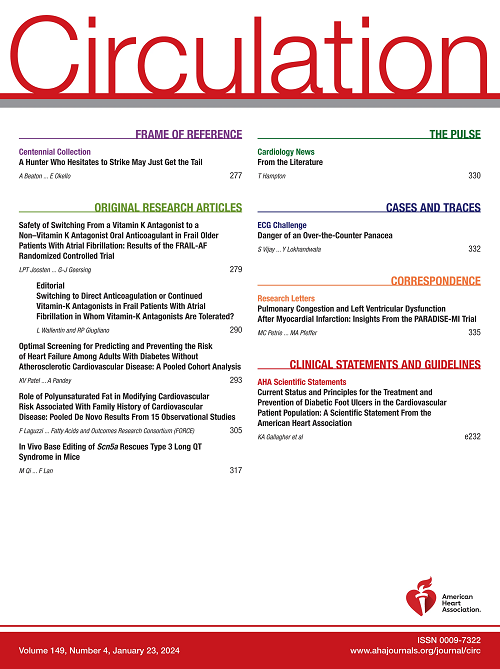High-Volume Physical Activity and Clinical Coronary Artery Disease Outcomes: Findings From the Cooper Center Longitudinal Study.
IF 35.5
1区 医学
Q1 CARDIAC & CARDIOVASCULAR SYSTEMS
引用次数: 0
Abstract
BACKGROUND High-volume physical activity (PA) is associated with a higher prevalence of subclinical coronary artery disease (CAD). However, the clinical significance of subclinical CAD among high-volume exercisers remains incompletely understood, and the dose-response relationship between high-volume PA and clinical CAD events remains uncertain. METHODS Individual participant data from the Cooper Center Longitudinal Study (1987-2018) were linked to Medicare claims files. PA volume was determined by self-report and categorized as <500, 500 to 1499, 1500 to 2999, and ≥3000 metabolic equivalent of task (MET)-minutes per week. Subclinical CAD (coronary artery calcium [CAC]) was measured by cardiac computed tomography. All other risk factors were measured in the standard fashion. Composite CAD events (acute myocardial infarction and revascularization) and all-cause mortality were determined from Medicare claims files. A multivariable-adjusted proportional hazards illness-death model with random shared frailty was used to estimate the association between PA volume, CAC, and both clinical CAD and death. Heterogeneity in the association between CAC and clinical CAD across levels of PA was determined with multiplicative interaction terms. RESULTS We included 26 724 participants (54 years of age; 28% women). Mean exercise volume was 1130 MET-minutes per week, with 1997 (7.5%) reporting ≥3000 MET-minutes per week. After a mean follow-up of 20.5 years, we observed 811 acute myocardial infarction events, 1636 composite CAD events, and 2857 deaths without CAD. Compared with individuals exercising <500 MET-minutes per week, the lowest risk for acute myocardial infarction occurred among individuals with intermediate PA volumes (500-1499 MET-minutes per week: hazard ratio [HR], 0.77 [95% CI, 0.65-0.91]; 1500-2499 MET-minutes per week: HR, 0.78 [95% CI, 0.63-0.95]). There was no association between high-volume PA (>3000 MET-minutesw per week) and risk for acute myocardial infarction (HR, 0.95 [95% CI, 0.72-1.25]). In contrast, the lowest risk for death was observed among the high-volume PA group (HR, 0.71 [95% CI, 0.60-0.83]). CAC (on log scale) was associated with a higher risk for composite CAD across all PA categories, including among the high-volume PA subgroup (HR, 1.29 [95% CI, 1.16-1.44]; P<0.001; Pinteraction= 0.969). CONCLUSIONS Compared with low-volume PA, high-volume PA was associated with a lower risk for all-cause mortality but a similar risk for clinical CAD. CAC was associated with an increased risk for clinical CAD regardless of the volume of PA.大运动量体育锻炼与临床冠状动脉疾病结果:库珀中心纵向研究结果》。
背景:高强度体力活动(PA)与亚临床冠状动脉疾病(CAD)的高患病率相关。然而,高强度运动者亚临床CAD的临床意义仍不完全清楚,高强度PA与临床CAD事件之间的剂量-反应关系仍不确定。方法:来自库珀中心纵向研究(1987-2018)的个体参与者数据与医疗保险索赔文件相关联。PA容量由自我报告确定,并分类为3000 met -min / week)和急性心肌梗死的风险(HR, 0.95 [95% CI, 0.72-1.25])。相比之下,高容量PA组的死亡风险最低(HR, 0.71 [95% CI, 0.60-0.83])。在所有PA类别中,CAC(对数尺度)与复合CAD的高风险相关,包括高容量PA亚组(HR, 1.29 [95% CI, 1.16-1.44];P < 0.001;Pinteraction = 0.969)。结论:与低容量PA相比,高容量PA与全因死亡风险较低相关,但与临床CAD风险相似。CAC与临床CAD的风险增加有关,与PA的体积无关。
本文章由计算机程序翻译,如有差异,请以英文原文为准。
求助全文
约1分钟内获得全文
求助全文
来源期刊

Circulation
医学-外周血管病
CiteScore
45.70
自引率
2.10%
发文量
1473
审稿时长
2 months
期刊介绍:
Circulation is a platform that publishes a diverse range of content related to cardiovascular health and disease. This includes original research manuscripts, review articles, and other contributions spanning observational studies, clinical trials, epidemiology, health services, outcomes studies, and advancements in basic and translational research. The journal serves as a vital resource for professionals and researchers in the field of cardiovascular health, providing a comprehensive platform for disseminating knowledge and fostering advancements in the understanding and management of cardiovascular issues.
 求助内容:
求助内容: 应助结果提醒方式:
应助结果提醒方式:


